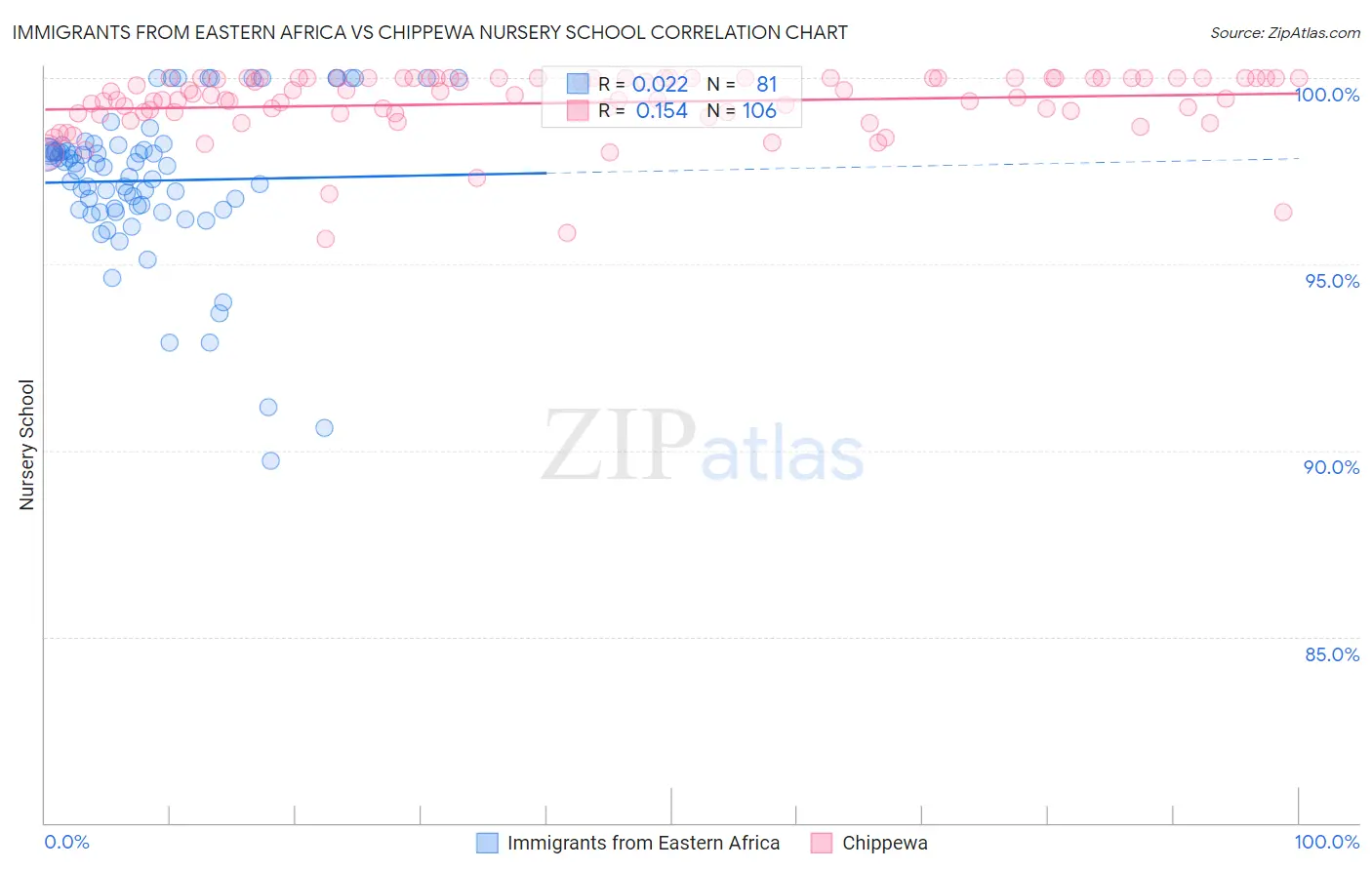Immigrants from Eastern Africa vs Chippewa Nursery School
COMPARE
Immigrants from Eastern Africa
Chippewa
Nursery School
Nursery School Comparison
Immigrants from Eastern Africa
Chippewa
97.6%
NURSERY SCHOOL
0.9/ 100
METRIC RATING
249th/ 347
METRIC RANK
98.5%
NURSERY SCHOOL
99.9/ 100
METRIC RATING
40th/ 347
METRIC RANK
Immigrants from Eastern Africa vs Chippewa Nursery School Correlation Chart
The statistical analysis conducted on geographies consisting of 355,144,184 people shows no correlation between the proportion of Immigrants from Eastern Africa and percentage of population with at least nursery school education in the United States with a correlation coefficient (R) of 0.022 and weighted average of 97.6%. Similarly, the statistical analysis conducted on geographies consisting of 215,065,644 people shows a poor positive correlation between the proportion of Chippewa and percentage of population with at least nursery school education in the United States with a correlation coefficient (R) of 0.154 and weighted average of 98.5%, a difference of 0.91%.

Nursery School Correlation Summary
| Measurement | Immigrants from Eastern Africa | Chippewa |
| Minimum | 89.7% | 95.7% |
| Maximum | 100.0% | 100.0% |
| Range | 10.3% | 4.3% |
| Mean | 97.2% | 99.3% |
| Median | 97.6% | 99.5% |
| Interquartile 25% (IQ1) | 96.5% | 99.0% |
| Interquartile 75% (IQ3) | 98.1% | 100.0% |
| Interquartile Range (IQR) | 1.7% | 0.95% |
| Standard Deviation (Sample) | 2.1% | 0.87% |
| Standard Deviation (Population) | 2.1% | 0.86% |
Similar Demographics by Nursery School
Demographics Similar to Immigrants from Eastern Africa by Nursery School
In terms of nursery school, the demographic groups most similar to Immigrants from Eastern Africa are Immigrants from Middle Africa (97.6%, a difference of 0.0%), Indian (Asian) (97.6%, a difference of 0.0%), Immigrants from Senegal (97.6%, a difference of 0.0%), Asian (97.6%, a difference of 0.010%), and South American (97.6%, a difference of 0.010%).
| Demographics | Rating | Rank | Nursery School |
| Liberians | 1.1 /100 | #242 | Tragic 97.7% |
| Asians | 1.1 /100 | #243 | Tragic 97.6% |
| South Americans | 1.0 /100 | #244 | Tragic 97.6% |
| Bolivians | 1.0 /100 | #245 | Tragic 97.6% |
| Peruvians | 1.0 /100 | #246 | Tragic 97.6% |
| Immigrants | Middle Africa | 0.9 /100 | #247 | Tragic 97.6% |
| Indians (Asian) | 0.9 /100 | #248 | Tragic 97.6% |
| Immigrants | Eastern Africa | 0.9 /100 | #249 | Tragic 97.6% |
| Immigrants | Senegal | 0.9 /100 | #250 | Tragic 97.6% |
| Ethiopians | 0.8 /100 | #251 | Tragic 97.6% |
| Immigrants | Africa | 0.8 /100 | #252 | Tragic 97.6% |
| Immigrants | Iraq | 0.7 /100 | #253 | Tragic 97.6% |
| Immigrants | Congo | 0.7 /100 | #254 | Tragic 97.6% |
| Immigrants | Asia | 0.7 /100 | #255 | Tragic 97.6% |
| Yaqui | 0.6 /100 | #256 | Tragic 97.6% |
Demographics Similar to Chippewa by Nursery School
In terms of nursery school, the demographic groups most similar to Chippewa are Latvian (98.5%, a difference of 0.0%), Lumbee (98.5%, a difference of 0.010%), Italian (98.5%, a difference of 0.010%), Luxembourger (98.5%, a difference of 0.010%), and Eastern European (98.5%, a difference of 0.010%).
| Demographics | Rating | Rank | Nursery School |
| Scandinavians | 100.0 /100 | #33 | Exceptional 98.6% |
| Chinese | 100.0 /100 | #34 | Exceptional 98.6% |
| Swiss | 100.0 /100 | #35 | Exceptional 98.6% |
| British | 100.0 /100 | #36 | Exceptional 98.5% |
| Lumbee | 99.9 /100 | #37 | Exceptional 98.5% |
| Italians | 99.9 /100 | #38 | Exceptional 98.5% |
| Latvians | 99.9 /100 | #39 | Exceptional 98.5% |
| Chippewa | 99.9 /100 | #40 | Exceptional 98.5% |
| Luxembourgers | 99.9 /100 | #41 | Exceptional 98.5% |
| Eastern Europeans | 99.9 /100 | #42 | Exceptional 98.5% |
| Native Hawaiians | 99.9 /100 | #43 | Exceptional 98.5% |
| Belgians | 99.9 /100 | #44 | Exceptional 98.5% |
| Northern Europeans | 99.9 /100 | #45 | Exceptional 98.5% |
| Hungarians | 99.9 /100 | #46 | Exceptional 98.5% |
| Czechoslovakians | 99.9 /100 | #47 | Exceptional 98.5% |